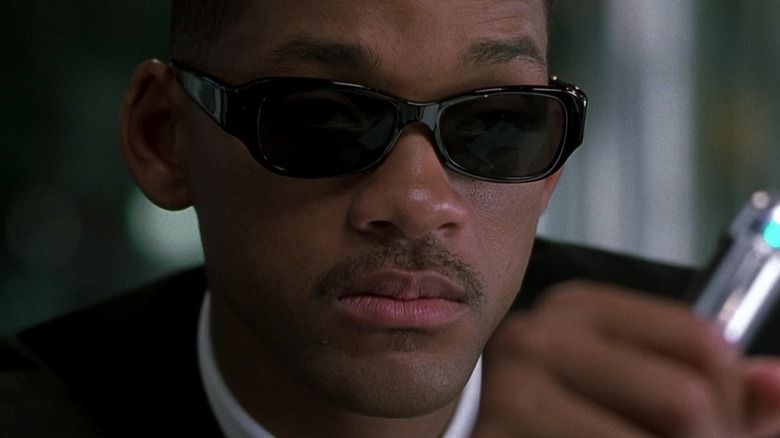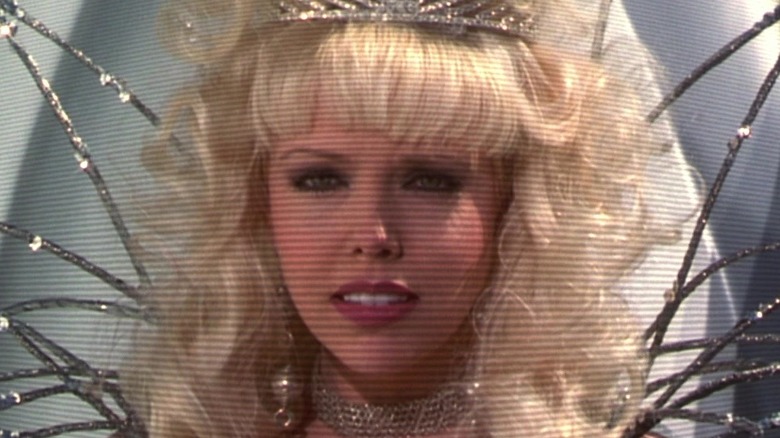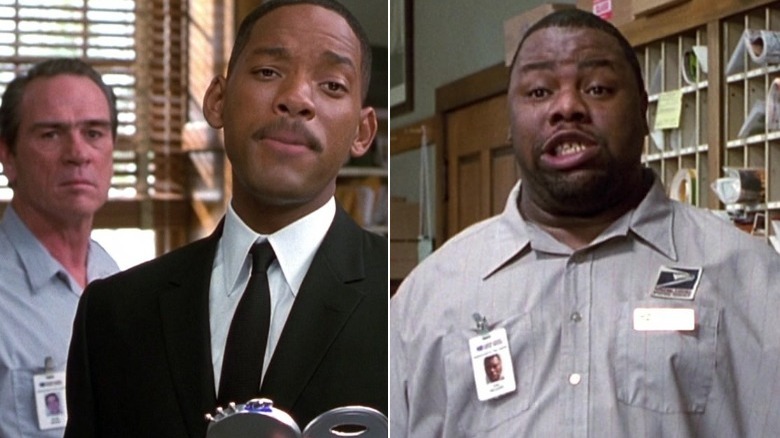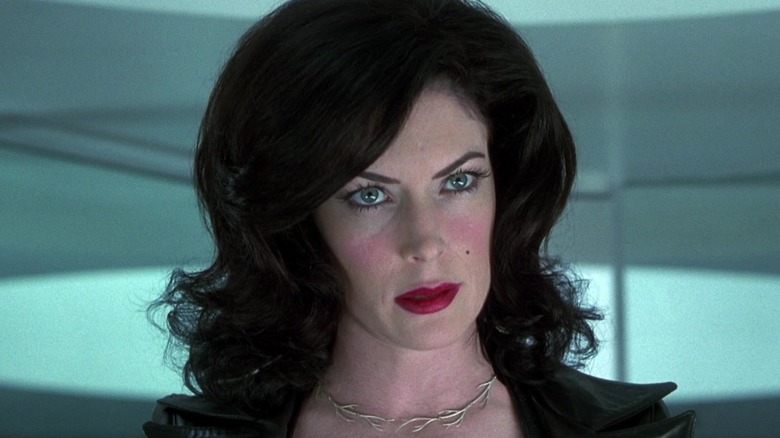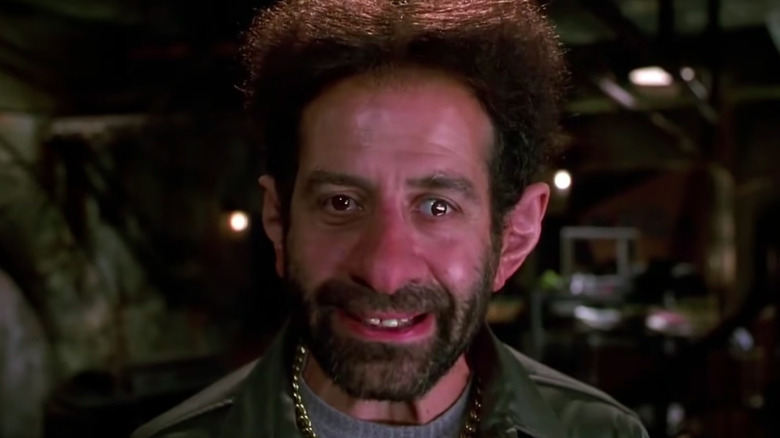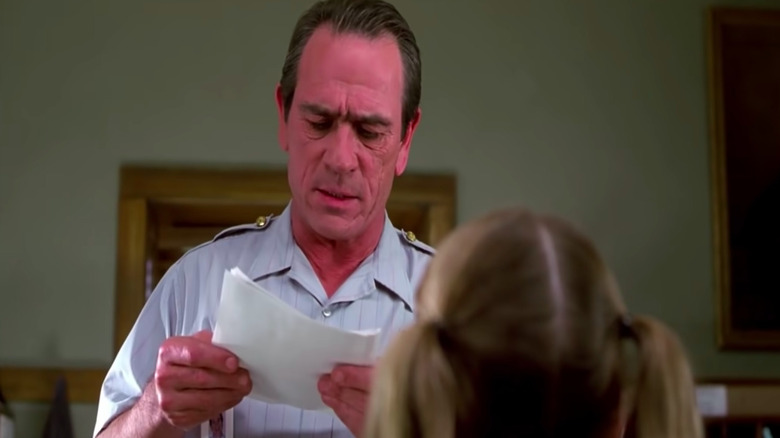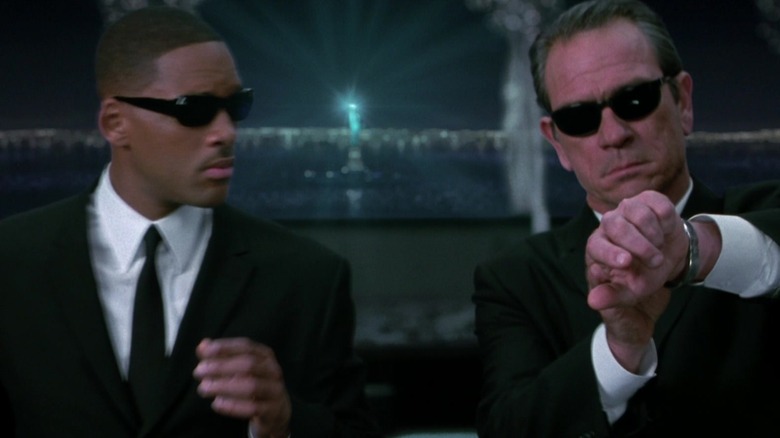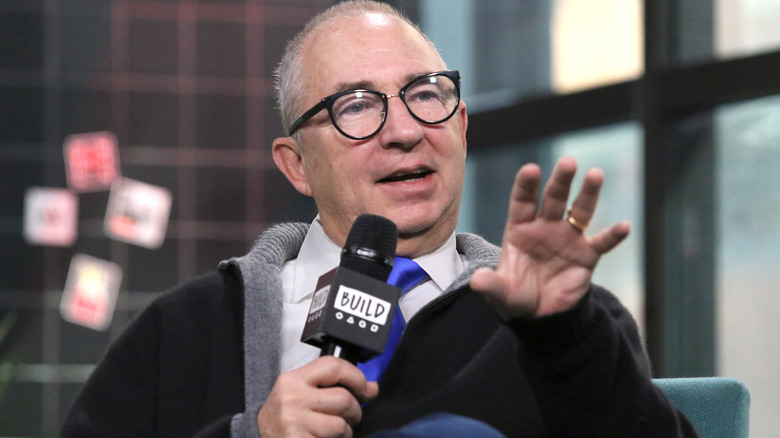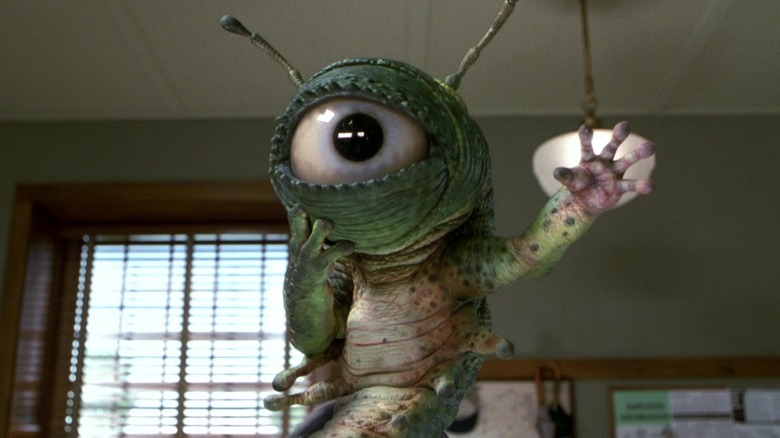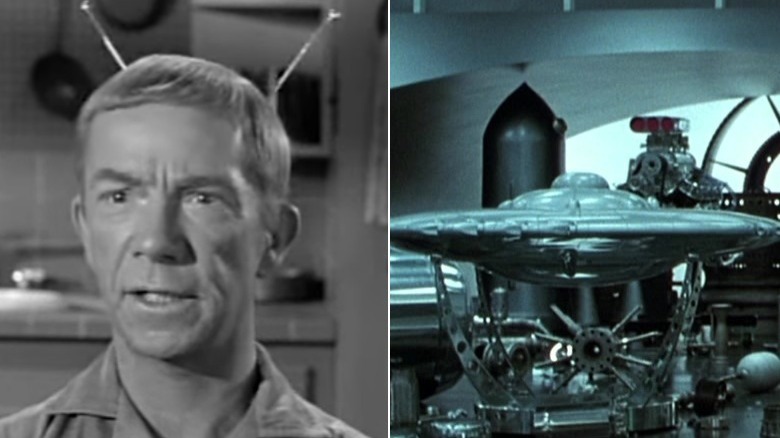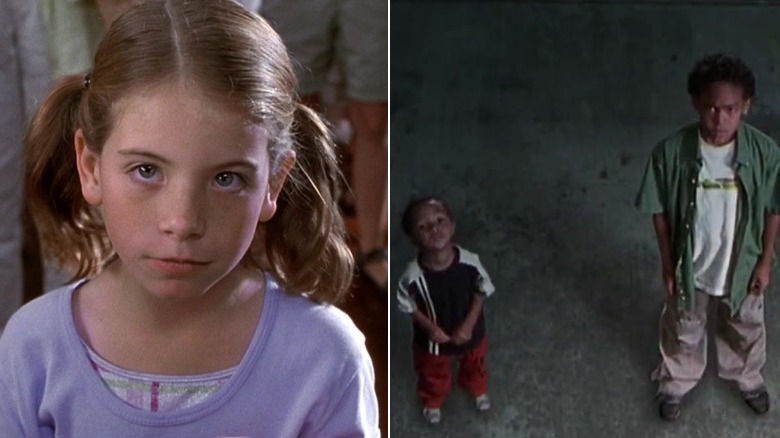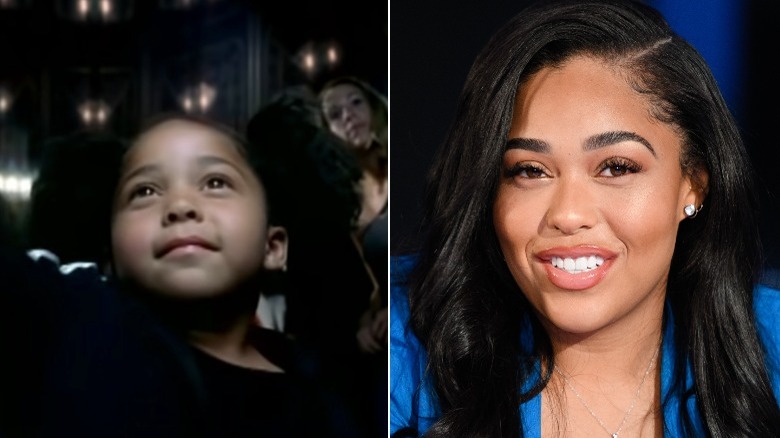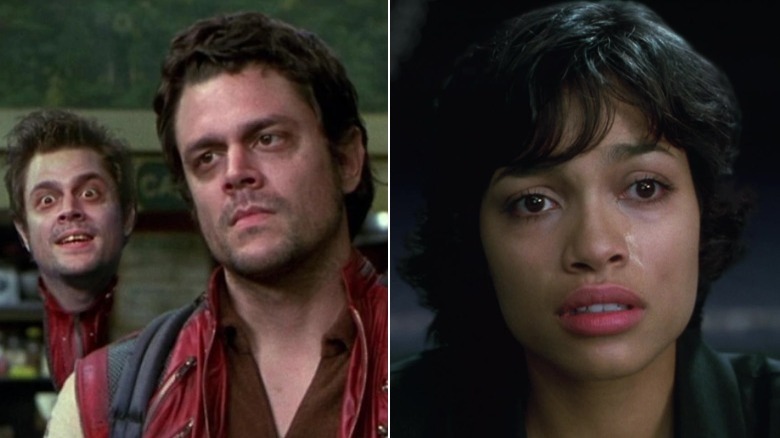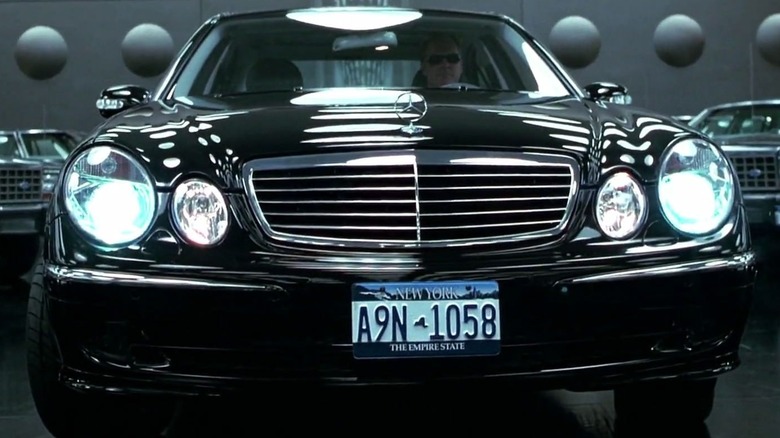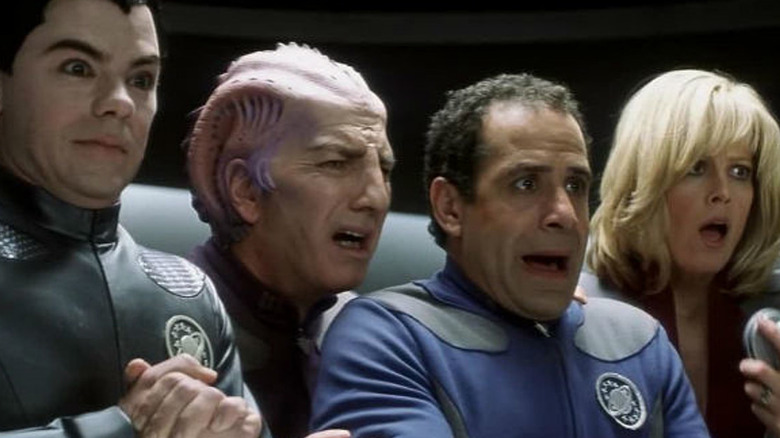The Untold Truth Of Men In Black II
The original "Men in Black" movie took off like a rocket after it landed in theaters on July 2, 1997. It's only natural, therefore, that Columbia Pictures would at least consider a follow-up. While fans got a more immediate "MIB" fix with the spectacular "Men in Black: The Series," Sony finally released a live-action sequel in 2002. "Men in Black II," also called "MIB II" or "MIIB," brought back many characters from the original film, including Will Smith's Agent J and Tommy Lee Jones' Agent K, pitting the duo against Lara Flynn Boyle's villainous Serleena and Johnny Knoxville's Scrad and Charlie. Not returning, however, was Linda Fiorentino's Agent L, despite being set up as K's replacement at the end of the first movie. In her place, however, are several new faces, including Laura Vasquez, played by Rosario Dawson.
Though "Men in Black II" did fairly well for itself domestically, it didn't quite match the winnings of its predecessor and was definitely more polarizing. Still, the movie has its fans, and there are plenty of interesting factoids that many viewers likely aren't aware of. Don your black suits and nod your heads, as the untold truth of "Men in Black II" is coming your way.
It started as a different movie
It's not uncommon for existing screenplays to be reworked into completely different movies, even for different franchises. One might easily suspect "Men in Black III" is the "MIB" film that started as something else, given that the franchise isn't particularly known for time travel. Yet as "Men in Black: The Official Visual Companion to the Films" reveals, it's not the story for "MIB III," but rather that of "MIB II" which had been envisioned for another project. Specifically, co-producer Walter Parkes had co-written a script with Larry Lassiter featuring the daughter of aliens who believe she'd be safer on Earth than in their care. While said script was never turned into a movie, its plot essentially became "MIB II" character Laura Vasquez's backstory.
Parkes, along with wife and fellow co-producer Laurie MacDonald, are also the ones who decided the movie would have a romantic element. The ending, in which J and Laura must suspend their romance so Laura can assume her responsibilities on Zartha, has similarities to "Casablanca," as Parkes himself notes in "The Official Visual Companion."
The untold truth behind the alien beatboxing battle
One of the more memorable early moments in the film involves Agent J visiting his neuralyzed ex-partner Kevin Brown aka Agent K, in a post office. While trying to remind Brown of his time as an MIB agent, J begins talking with one of the disguised alien postal workers in his native language. A stunned Brown then watches as the other post office colleagues in the room remove parts of their human costumes, proving J's story true.
Many would point out that J's conversation with the first postal worker sounds a whole lot like beatboxing, and with good reason. After all, both characters are played by famous rap and hip-hop artists. Will Smith, of course, is J, while the alien he's conversing with is fellow music legend Biz Markie, the Clown Prince of Hip-Hop himself. Smith's beatboxing is the most overt, as the rapper even covers part of Slick Rick's famous "La Di La Di," as "The Official Visual Companion" points out. Yet while the sounds Markie makes seem more otherworldly by comparison, don't mistake them for sound effects. Markie's vocals are completely untouched by digital technology, a testament to his tremendous range as a vocal performer.
Lara Flynn Boyle wasn't always going to play Serleena
One of the highlights of "Men in Black II" is Lara Flynn Boyle's performance as Serleena, the Kylothian who'll go through anyone in her way to bring the enigmatic Light of Zartha to her people. Boyle handles all of Serleena's facets, from her toughness and humor to her seductive tactics, with aplomb, to the point that it's hard to imagine anyone else in the role.
Yet in fact, a different actress had originally been cast as the character. Though Boyle had auditioned, the role of Serleena first belonged to Famke Janssen, who by then was no stranger to blockbuster movies. Sadly, personal matters prevented Janssen, whose character Xenia Onatopp had vexed James Bond in "GoldenEye," from adding Serleena to her movie villain resume. It would have been interesting to see how Janssen would have approached the character of Serleena, though there's no denying Boyle did a spectacular job.
There's a reason Jeebs looks slightly different
Poor Jack Jeebs. Sure, he's pretty dishonest as far as humans and aliens from other worlds go, but it's not easy getting your head blown up all the time. While the first "Men in Black" movie quickly shows how that particular injury is only a temporary (if painful) inconvenience for Jeebs, sharp-eyed "Men in Black II" viewers might have noticed a few differences from how he last appeared ... and we don't just mean the beard.
As it turns out, those minor differences, including an ear that's bigger than the other, have a story behind them. As "The Official Visual Companion" elucidates, prosthetics and other techniques are used to slightly alter Jeebs' facial features. Why, you ask? To give off the impression that having to reconstruct his noggin' over and over again has overtaxed his regeneration power, meaning not every feature grows back the way it did before. Probably a good incentive for Jeebs to consider switching to a more honest lifestyle or reporting K to his superiors at MIB, although something tells us the latter wouldn't be so effective.
There was less time to polish the script
The script for the first "Men in Black" movie, as Den of Geek observes, had been in production since 1992. What came after were many rewrites, primarily by the screenplay's original author, Ed Solomon (though he tells Inverse that "Jurassic Park" screenwriter David Koepp also made a notable revision), at the studio's and director Barry Sonnenfeld's request. Script changes continued well into production, including J's showdown with the Bug rewritten to be more action-heavy and an alien species once crucial to the plot completely removed through clever editing.
Conversely, the script for "Men in Black II" neither had the same development time nor the same level of story input Sonnenfeld had on the previous film, the director tells Insider. That said, Sonnenfeld was able to get some changes in, most notably speeding up K's return to reestablish K and J's comedy dynamic.
A pivotal scene changed due to 9/11
The September 11, 2001 attacks on the United States had a huge, immediate impact on the world, and the entertainment industry was no exception. Movies, television shows, and even teaser trailers displaying or referencing the World Trade Center were changed or even pulled from circulation. For "Men in Black II," which is mainly set in New York, the attacks meant shifting the location of the big final battle with Serleena, which originally was set on one of the Twin Towers.
The change doesn't drastically affect the plot, with Barry Sonnenfeld even noting to TV Guide that placing the fight (and Laura's goodbye) on a Twin Tower would have been done mainly for aesthetic purposes. Ultimately, the building used in the finished film, as "The Official Visual Companion" observes, is both a set the crew created and the top of a building in Battery Park, depending on the shot. The change worked out pretty well, as the partly fictitious rooftop allowed the filmmakers to place the building close enough for K to activate the Statue of Liberty's neuralyzer. It also allowed for more liberty in how the roof was designed, which is why parts of it look like the bracelet everyone thought was the Light at first.
The director has very specific things he'd change about the film
In general, the people involved in "Men in Black II" have been fairly candid about why they feel the film didn't quite match the original's success. Tommy Lee Jones, for instance, has said he feels the movie doesn't quite match the uniqueness of its predecessor, while Will Smith appears to have his own misgivings.
It's not surprising, therefore, that director Barry Sonnenfeld has some ideas on how the film could have been done differently. When asked by MTV, he explained, "I would have made sure, A, that we had a better villain; and B, that we realized that the strength of the series was not comedy but much more about character development; and C, we didn't rush into production and had more time to get the script right so it could have been more emotional." Those lessons, Sonnenfeld explains, are incorporated into "Men in Black III," which is the better-received of the sequels.
Some of the aliens' names are goofy even by Men in Black standards
When you have a character from another planet called "Frank" (assuming it's not an alias), you know that alien names in "Men in Black" aren't meant to be taken too seriously. Even "Men in Black: The Series" has fun with naming, including giving one alien the very human name of "Harry Dribble" in the episode "The Zero to Superhero Syndrome."
"Men in Black II," however, takes this to a whole other level. While likely not the in-universe names of these aliens, certain extraterrestrial characters were given very tongue-in-cheek monikers by the crew and in the credits, usually due to their appearance. That alien who kind of looks like cream corn, for instance? Why, that's Corn Face, of course. Similarly, the dog-like alien who J compares to excrement is, you guessed it, Dog Poop. Similarly, the aliens in K's mailroom also have very on-the-nose names. The one-eyed alien who hides his appearance under the head of his human costume? Eye Guy, naturally.
The very subtle My Favorite Martian homage
One of the big draws of the "Men in Black" franchise is how unique everything looks, from the weapons to the aliens. It's not easy to trace the movies to a specific sci-fi predecessor, as it has an aesthetic all its own.
"Men in Black II," however, has a scene with an object that's literally from right out of a classic series: namely one of the miniature "flying saucers" used in the original "My Favorite Martian" television show. Set decorator Cheryl Carasik explains in "The Official Visual Companion" that she rented the famous show's prop from a collector. With a little chrome paint and added rocket bits, the ship easily fit in with MIB headquarters' gray and silver palette. The ship can be seen when Agent J saves Laura and fights one of Serleena's villainous allies, Jarra (John Alexander).
It's a fitting choice, seeing as "My Favorite Martian" is about a benevolent being from space living on Earth, much like most "Men in Black" aliens. Hopefully the show's interplanetary lead, Exigius 12½ (better known as "Martin O'Hara" or "Uncle Martin"), didn't stop by afterward asking for his ship back!
Will Smith and Barry Sonnenfeld's children cameo
Personal connections aren't easy to make if you're a Men in Black agent, especially since the rest of the world can't know about you. Thankfully, that's not the case for the franchise's cast and crew, who incorporate family members into "Men in Black II" in very cool ways. Barry Sonnenfeld's daughter Chloe, whom Barry tells Collider is the toddler on the screen of aliens in the first "Men in Black," is also (as "The Official Visual Companion" states) Elizabeth, the young girl asking Agent K for stamps in "Men in Black II." Could Elizabeth have grown up to become the otherwise-nameless "Connie Island Flower Child," who's also played by the younger Sonnenfeld in MIB's third live-action outing?
Will Smith's own children at the time, who've frequently appeared in his work, also joined the "Men in Black II" party. Jaden Smith, now a pretty big name in the entertainment world himself, gets a worm's-eye view of Serleena's aerial pursuit of Laura, K and J, as does Jaden's older brother Trey, who today is a notable DJ. Sadly for Jaden and Trey's characters, however, the two are immediately neuralyzed the moment their off-screen dad's sweet ride zooms above them.
The famous future star who hands Will Smith his sunglasses
The "Men in Black II" music video for the song "Black Suits Comin' (Nod Ya Head)" has many cameos worth noting. Like in the movie, Will's two sons appear, as do certain extraterrestrial characters from the film, like the eight-armed Postal Sorting Alien and the Grand Central Station locker aliens. Yet here's one that might stump many people: Can you name the now-famous celebrity who hands Agent J his sunglasses after they're knocked from his face?
It's not Will Smith's daughter, Willow, who would have been at most 1 or 2 years old when the music video was made. Instead, it's none other than model and "The Masked Singer" sensation Jordyn Woods, the Dankanator explains. Not only that, but she was filling in for Smith's younger son Jaden, who was originally meant to be the one giving his father back the sunglasses. We can only hope Agent J made Woods an honorary MIB agent afterward.
The novelization has some huge differences
Book adaptations of movies are often a little different from the films themselves. Usually, the dissimilarities stem from the author either adding their own ideas, working off a previous version of the movie's script, or both.
It's unclear whether the novelization for "Men in Black II" is based on an earlier script draft, but it's sure got its differences. The Worm Guys, for instance, get a pretty impressive battle scene with a bunch of gun-toting alien crickets in an air vent, ending when the Worms' sliced-off body parts regenerate into a full-on Worm Guy army. Meanwhile, Serleena's right-hand men (well, right-hand man and head) Scrad and Charlie actually rebel against their boss and help K and J kill her with a weapon of Serleena's that's absent from the movie, a Proton Imploder.
Shockingly, the book also changes a crucial movie plot point. Instead of Laura Vasquez's being the Light of Zartha and the daughter of Princess Lauranna, she's a mere human in the novel, and her bracelet's the Light after all. Further, after the Light's sent to Zartha, J must decide whether to neuralyze Laura or have K neuralyze him so he and Laura can pursue a long-term romance. Knowing that the latter option would end his MIB days, J chooses to stay with the organization, wiping Laura's memories of their meeting. At least Laura doesn't have to leave Earth in this version, right?
The car that became a toy
In the original "Men in Black" movie, Agent J isn't too impressed by the car he and Agent K would drive around with, a 1987 Ford LTD Crown Victoria, at first. Yet all that changes when K has him push the car's red button, revealing there's much more to the unassuming vehicle than meets the eye.
Despite this, however, J decides to get a car that's a little more his speed — figuratively — for "Men in Black II." Enter J's 2003 Mercedes-Benz E500 (W211), which, aside from being one slick-looking ride, has several features the LTD doesn't, including flight and a retractable dummy driver. Naturally, such a cool car, like pretty much anything from the "MIB" franchise, can also make the basis for a pretty neat toy, namely Hasbro's "Men in Black" Strike Cruiser. Not only does the Strike Cruiser come with an Agent J figure, but it's also the first licensed toy ever to officially have the Mercedes-Benz logo on it (per Autos.ca). The logo definitely gives the toy an extra level of authenticity, even though you're still more likely to find it in a toy store than a car dealership.
Its multiple Galaxy Quest connections
"Men in Black" is one of the great sci-fi comedies of the '90s, but it's in good company. Enter "Galaxy Quest," the beloved 1999 film in which a group of actors on a "Star Trek"-like TV series is approached by aliens who think the show is real. The movies have plenty of things in common, including their originality, humor, and major star power.
However, "Galaxy Quest" has even more in common with "Men in Black II." For one, the two films share a co-writer, Robert Gordon, who co-pens the "Men in Black" sequel instead of its original screenwriter, Ed Solomon. Furthermore, the two movies share an actor, Tony Shalhoub, who's Jack Jeebs in the "Men in Black" movies and Fred Kwan in "Galaxy Quest." One can't help but imagine a crossover between the two franchises, although Kwan may want to make absolutely sure Agent K doesn't confuse him with Jeebs.
